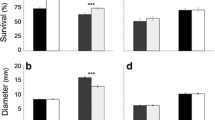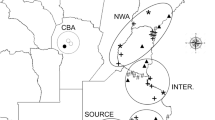Abstract
The dynamics of plant population differentiation may be integral in predicting aspects of introduced species invasion. In the present study, we tested the hypothesis that European populations of Senecio inaequidens (Asteraceae), an invasive species with South African origins, differentiated during migration from two independent introduction sites into divergent altitudinal and climatic zones. We carried out 2 years of common garden experiments with eight populations sampled from Belgian and ten populations from French altitudinal transects. The Belgian transect followed a temperature and precipitation gradient. A temperature and summer drought gradient characterized the French transect. We evaluated differentiation and clinal variation in plants germinated from field-collected seed using the following traits: days to germination, days to flowering, height at maturity, final plant height and aboveground biomass. Results showed that S. inaequidens populations differentiated in growth traits during invasion. During the 1st year of sampling, the results indicated clinal variation for growth traits along both the Belgium and French altitudinal transects. Data from the 2nd year of study demonstrated that with increasing altitude, a reduction in three growth traits, including plant height at maturity, final plant height and aboveground biomass, was detected along the French transect, but no longer along the Belgian one. Phenological traits did not exhibit a clear clinal variation along altitudinal transects. The possible evolutionary causes for the observed differentiation are discussed.




Similar content being viewed by others
References
Barrett SCH, Husband BC (1990) Genetics of plant migration and colonization. In: Brown AHD, Clegg MT, Kahler AL and Weir BS (eds) Plant population genetics, breeding and genetic resources. Sinauer Associates, pp 254–277
Blanckenhorn WU (1997) Altitudinal life history variation in the dung flies Scathophaga stercoraria and Sepsis cynipsea. Oecologia 109:342–352
Bossdorf O, Auge H, Lafuma L, Rogers WE, Siemann E, Prati D (2005) Phenotypic and genetic differentiation between native and introduced plant populations. Oecologia 144:1–11
Bossdorf O, Lipowsky A, Prati D (2008) Selection of preadapted populations allowed Senecio inaequidens to invade Central Europe. Divers Distrib 14:676–685
Callaway RM, Maron JL (2006) What have exotic plant invasions taught us over the past 20 years? Trends Ecol Evol 21:369–374
Clausen J, Keck DD, Hiesey WM (1941) Regional differentiation in plant species. Am Nat 75:231–250
Cox GW (2004) Alien species and evolution. Island Press, Washington
D’Antonio C (1993) Mechanisms controlling invasion of coastal plant communities by the alien succulent Carpobrotus Edulis. Ecology 74:83–95
Dietz H, Edwards PJ (2006) Recognition that causal processes change during plant invasion helps explain conflicts in evidence. Ecology 87:1359–1367
Ellstrand NC, Schierenbeck KA (2006) Hybridization as a stimulus for the evolution of invasiveness in plants? Euphytica 148:35–46
Endler JA (1977) Geographic variation, speciation, and clines. Princeton University Press, Princeton
Ernst WHO (1998) Invasion, dispersal and ecology of the South African neophyte Senecio inaequidens in the Netherlands: from wool alien to railway and road alien. Acta Bot Neerl 47:131–151
Etterson JR, Delf DE, Craig TP, Ando Y, Ohgushi T (2007) Parallel patterns of clinal variation in Solidago altissima in it native range in central USA and it invasive range in Japan. Botany 86:91–97
Galen C, Shore JS, Deyoe H (1991) Ecotypic divergence in alpine Polemonium viscosum: genetic structure, quantitative variation, and local adaptation. Evolution 45:1218–1228
Galloway LF (2005) Maternal effects provide phenotypic adaptation to local environmental conditions. New Phytol 166:93–100
Gilchrist GW, Huey RB, Balanyà J, Pascual M, Serra L (2004) A time series of evolution in action: a latitudinal cline in wing size in South American Drosophila subobscura. Evolution 58:768–780
Griffith TM, Watson MA (2006) Is evolution necessary for range expansion? Manipulating reproductive timing of a weedy annual transplanted beyond its range. Am Nat 167:153–164
Guillerm JL, Floc’h El, Maillet J, Boulet C (1990) The invading weeds in the Mediterranean Basin. In: di Castri F, Hansen AJ, Debussche M (eds) Biological invasions in Europe and the Mediterranean Basin. Kluwer, Dordrecht
Hemborg AM, Karlsson PS (1998) Altitudinal variation in size effects on plant reproductive effort and somatic costs of reproduction. Ecoscience 5:517–525
Huey RB, Gilchrist GW, Carlson ML, Berrigan D, Serra L (2000) Rapid evolution of a geographic cline in size in an introduced fly. Science 287:308–309
Jovet P, Vilmorin R (1975) Troisième supplément de La flore descriptive et illustrée de La France de l’abbé Coste. Librairie Scientifique et Technique Albert Blanchard, Paris
Kliber A, Eckert CG (2005) Interaction between founder effect and selection during biological invasion in an aquatic plant. Evolution 59:1900–1913
Kolar CS, Lodge DM (2001) Progress in invasion biology: predicting invaders. Trends Ecol Evol 16:199–204
Kollmann J, Banuelos MJ (2004) Latitudinal trends essai in growth and phenology of the invasive alien plant Impatiens glandulifera (Balsaminaceae). Divers Distrib 10:377–385
Körner C (1999) Alpine plant life. Springer, Heidelberg
Kuhbier H (1977) Senecio inaequidens DC- ein Neubürger der nordwestdeutschen. Flora Abh Naturwiss Ver Bremen 43:531–536
Lacey EP (1988) Latitudinal variation in reproductive timing of a short-lived monocarp, Daucus carota (Apiaceae). Ecology 69:220–232
Lafuma L, Balkwill K, Imbert E, Verlaque R, Maurice S (2003) Ploidy level and origin of the European invasive weed Senecio inaequidens (Asteraceae). Plant Syst Evol 243:59–72
Lafuma L, Maurice S (2007) Increase in mate availability without loss of self-incompatibility in the invasive species Senecio inaequidens (Asteraceae). Oikos 116:201–208
Lebeau J, Duvigneaud J, Delvosalle L, Depasse S (1978) Senecio inaequidens DC, S. vernalis Wadst. et Kit. et S. squalidus L., trois séneçons adventices en voie d’extension progressive et de naturalisation en Belgique. Natura Mosana 31:28–36
Lee CE (2002) Evolutionary genetics of invasive species. Trends Ecol Evol 17:386–391
Leger EA, Rice KJ (2007) Assessing the speed and predictability of local adaptation in invasive California poppies (Eschscholzia californica). J Evol Biol 20:1090–1103
Lopez-Garcia MC, Maillet J (2005) Biological characteristics of an invasive African species. Biol Invasions 7:181–194
Lousley JE (1961) A census list of wool aliens found in Britain, 1946–1960. Proc Bot Soc Br Isles 4:221–247
Maron JL, Vilà M, Bommarco R, Elmendorf S, Beardsley P (2004) Rapid evolution of an invasive plant. Ecol Monogr 74:261–280
Michez JM (1995) Le séneçon du Cap, de la laine à la vigne. Phytoma 468:39–41
Mihulka S, Pysek P (2001) Invasion history of Oenothera congeners in Europe: a comparative study of spreading rates in the last 200 years. J Biogeogr 28:597–609
Montague JL, Barrett SCH, Eckert CG (2008) Re-establishment of clinal variation in flowering time among introduced populations of purple loosestrife (Lythrum salicaria, Lythraceae). J Evol Biol 21:234–245
Monty A, Stainier C, Lebeau F, Pieret N, Mahy G (2008) Seed rain pattern of the invasive weed Senecio inaequidens (Astreraceae). Belg J Bot 141:51–63
Mosseray R (1936) Matériaux pour une flore de Belgique. V. Genre Senecio. Bull Jard Bot Nat Belg 14:57–82
Parker IM, Rodriguez J, Loik ME (2003) An evolutionary approach to understanding the biology of invasions: local adaptation and general-purpose genotypes in the weed Verbascum thapsus. Conserv Biol 17:59–72
Pignatti S (1982) Flora d’Italia. Edagricole, Bologna
Pimentel D, Lach L, Zuniga R, Morrison D (2000) Environmental and economic costs of nonindigenous species in the United States. Bioscience 50:53–65
Rice KJ, Mack RN (1991) Ecological genetics of Bromus tectorum. III. The demography of reciprocally sown populations. Oecologia 88:91–101
Roach DA, Wulff RD (1987) Maternal effects in plants. Annu Rev Ecol Evol Syst 18:209–235
Sakai AK, Allendorf FW, Holt JS, Lodge DM, Molofsky J, With KA, Baughman S, Cabin RJ, Cohen JE, Ellstrand NC, McCauley DE, O’Neil P, Parker IM, Thompson JN, Weller SG (2001) The population biology of invasive species. Annu Rev Ecol Evol Syst 32:305–332
Sax DF, Stachowicz JJ, Brown JH, Bruno JF, Dawson MN, Gaines SD, Grosberg RK, Hastings A, Holt RD, Mayfield MM, O’Connor MI, Rice WR (2007) Ecological and evolutionary insights from species invasions. Trends Ecol Evol 22:465–471
Senay P (1944) Le Séneçon adventice de Mazamet. Bulletin de la Société Botanique de France 91:111–113
Sexton JP, McKay JK, Sala A (2002) Plasticity and genetic diversity may allow saltcedar to invade cold climates in North America. Ecol Appl 12:1652–1660
Siemann E, Rogers WE (2001) Genetic differences in growth of an invasive tree species. Ecol Lett 4:514–518
von Arx G, Edwards PJ, Dietz H (2006) Evidence for life history changes in high-altitude populations of three perennial forbs. Ecology 87:665–674
Weber E, Schmid B (1998) Latitudinal population differentiation in two species of Solidago (Asteraceae) introduced into Europe. Am J Bot 85:1110–1121
Acknowledgments
We thank S. Maurice for useful information about French populations and Guy Buchet for technical assistance during the whole research project. Comments from I. Nijs, R. Irwin and two anonymous reviewers on a previous version of the manuscript were highly valuable and appreciated. This research was supported by the project FRFC 2.4605.06 from the Belgian Fonds National de la Recherche Scientifique. Arnaud Monty holds a doctoral grant from the Fonds National de la Recherche Scientifique. The experiments in this study comply with the current laws of the country in which they were performed.
Author information
Authors and Affiliations
Corresponding author
Additional information
Communicated by Rebecca Irwin.
Electronic supplementary material
Below is the link to the electronic supplementary material.
442_2008_1228_MOESM1_ESM.xls
S1: Principal component analysis performed on climatic data from the climatic stations along each transect. Correlations of each climatic variable with the two first PCA axes (referred to as PCA 1 CLIMATE and PCA 2 CLIMATE) are presented. Significant correlations are in bold. For each axis, the eigenvalue and the explained variance are given. (XLS 28 kb)
442_2008_1228_MOESM2_ESM.xls
S2: Pearson’s coefficient of correlation among the measured plant traits, calculated on mean population values, for both transects and both years together. Significant correlations are in bold. (XLS 22 kb)
442_2008_1228_MOESM3_ESM.xls
S3: Principal component analysis performed on plant traits, for the 2 years of the experiment and along the two transects. Correlations of each trait with the first PCA axis (referred to as PCA 1 PLANT TRAIT) are presented. Significant correlations are in bold. For each PCA 1 PLANT TRAIT axis, the eigenvalue and the explained variance are given. (XLS 25 kb)
Rights and permissions
About this article
Cite this article
Monty, A., Mahy, G. Clinal differentiation during invasion: Senecio inaequidens (Asteraceae) along altitudinal gradients in Europe. Oecologia 159, 305–315 (2009). https://doi.org/10.1007/s00442-008-1228-2
Received:
Accepted:
Published:
Issue Date:
DOI: https://doi.org/10.1007/s00442-008-1228-2




